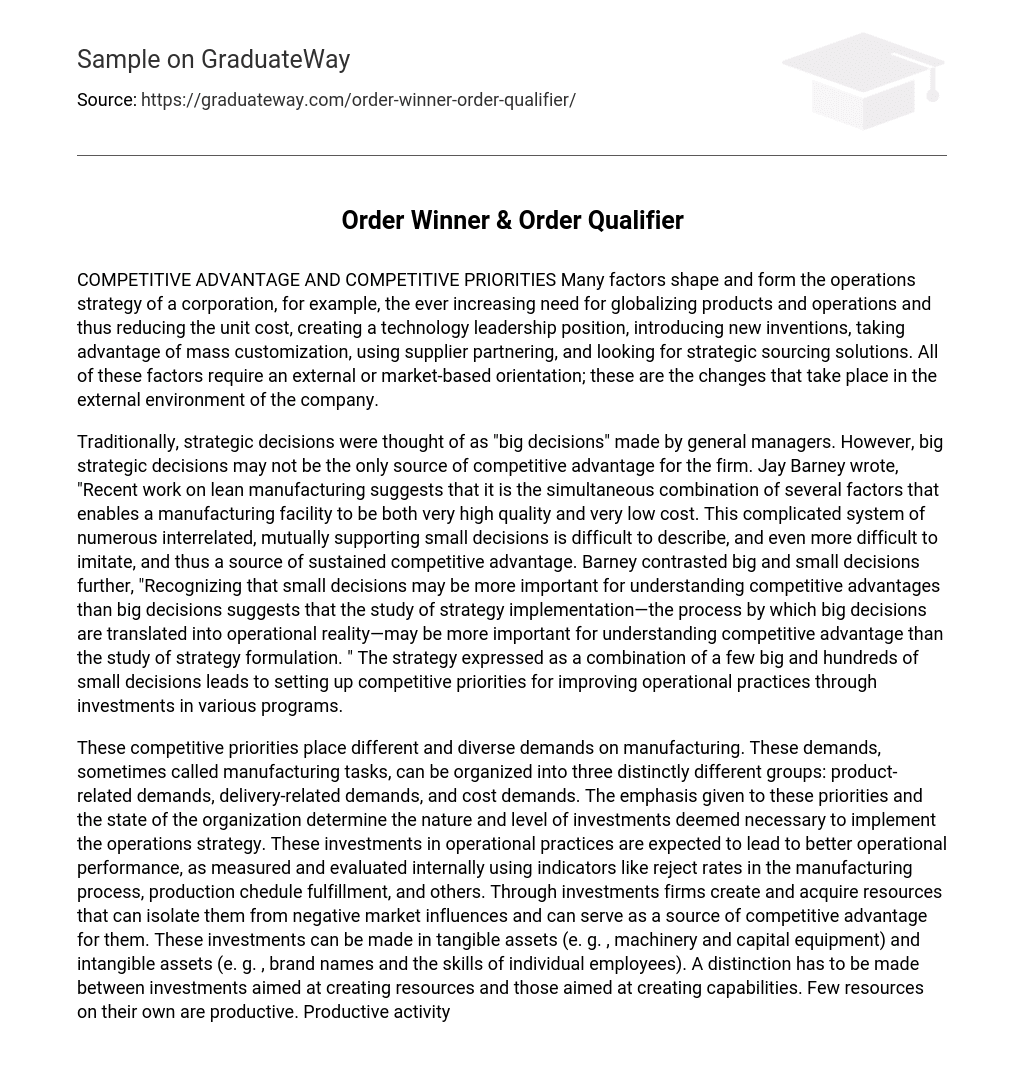COMPETITIVE ADVANTAGE AND COMPETITIVE PRIORITIES
The operations strategy of a corporation is influenced by multiple factors, including the necessity to globalize products and operations to reduce costs, establish a technology leadership position, introduce innovations, leverage mass customization, engage in supplier partnering, and seek strategic sourcing solutions. These factors necessitate an external or market-oriented approach, as they are driven by changes in the company’s external environment.
Traditionally, strategic decisions were considered to be major decisions made by top managers. However, it is now understood that competitive advantage for a company may not solely come from big strategic decisions. Jay Barney argues that lean manufacturing indicates it is the simultaneous combination of multiple factors that allows a manufacturing facility to achieve both high quality and low cost. This intricate system of many interconnected small decisions is challenging to explain and even harder to replicate, thus becoming a source of sustained competitive advantage. Barney further distinguishes between big and small decisions, stating that recognizing the importance of small decisions in understanding competitive advantages implies that studying the process of strategy implementation, where big decisions are translated into operational reality, may be more crucial in understanding competitive advantage than studying strategy formulation. Therefore, a strategy comprising a few big and numerous small decisions establishes competitive priorities for enhancing operational practices through investments in different programs.
Manufacturing places various demands into three categories: product-related demands, delivery-related demands, and cost demands. The necessary investments for implementing the operations strategy depend on the emphasis on these priorities and the organization’s current state. These investments aim to enhance operational performance by improving indicators such as reject rates and production schedule fulfillment. By making investments, firms acquire resources that safeguard them from market influences and provide a competitive advantage. These resources can be tangible assets like machinery and capital equipment or intangible assets like brand names and employee skills. It is crucial to differentiate between investments that create resources and those that create capabilities. Collaboration and coordination of resource teams are essential for productive activity.
An operational capability is the capacity of a group of resources to perform a specific task or activity. These capabilities provide a competitive advantage for a company, with resources serving as their foundation. Rather than being evaluated individually, it is important to compare these capabilities to those of competitors. Therefore, it is essential to differentiate between dimensions of competitiveness like price, place, and product, and dimensions based on capabilities such as cost, time, and quality. These dimensions encompass both the internal abilities of a company and how they are perceived in the market.
ORDER QUALIFIERS AND ORDER WINNERS
In the realm of marketing, Terry Hill proposes that there are two types of criteria that dictate success in the marketplace: order qualifiers and order winners. Order qualifiers are essential attributes of a product or service that make it worthy of consideration by customers. On the other hand, order winners are distinctive features that secure a victory in bidding or convince customers to complete a purchase.
Firms need to meet certain criteria in order to enter or stay in the market, which ensures that they are on an equal footing with their competitors. If these standards are not met, it may lead to decreased sales. However, exceeding these requirements is crucial for firms that want a competitive advantage. It is important to understand that meeting the minimum requirements (order qualifiers) holds the same importance as achieving factors that set one apart from competition (order winners), even though they serve different purposes. Consequently, firms should make informed decisions based on both order winners and qualifiers.
For instance, let’s consider a firm that manufactures a product of exceptional quality (where high quality is the determining factor for success). If the production cost of maintaining such a high level of quality causes the product’s price to surpass a particular threshold (which is a prerequisite for consideration), it can result in decreased sales, thus making “quality” a factor that detracts from competitiveness. Both order winners and qualifiers are contingent upon the market and time, operating in various combinations and manners for different markets and customers.
Although certain trends can be identified in different markets, they may not remain consistent over time. For example, during the late 1990s, delivery speed and product customization were often considered crucial factors for winning orders, while product quality and price, which had previously been important, became more like prerequisites. Therefore, companies must develop diverse strategies to meet various marketing needs, and these strategies must evolve as time progresses.
Moreover, it is vital for firms to focus on studying customer behavior rather than relying solely on their verbalized preferences since customers’ stated needs may not always align with their actual purchasing habits. When a company’s perception of order success factors matches the customers’ perspective, there is a “fit” between the two viewpoints. This alignment typically leads to positive sales performance.
However, research conducted by Sven Horte and Hakan Ylinenpaa and published in the International Journal of Operations and Production Management revealed a significant disparity between managers’ and customers’ opinions regarding why they engaged in business together.
The sales performance of a firm was found to be favorable when there was alignment between the firm’s perception of product strengths and the customers’ perception of the product. On the other hand, if firms had high opinions about their competitive strengths but customers did not share this view, sales performance was negative.





